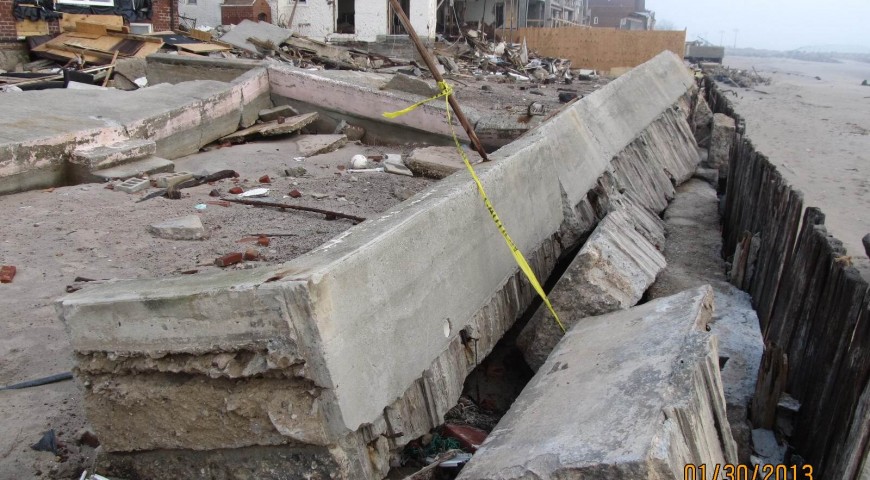This morning, after reviewing the damage we witnessed yesterday, we set out in the cold crisp air to provide more hurricane damage assessments, but this time we’d be right in the Big Apple. We started in Rockaway Park, NY, where the house we inspected again appeared like there had been only minor damage. But again, as we walked around the house, Sandy’s winds couldn’t hide what they had done. There were again cracks in the foundation. This time they were present on the gable-end side of the house. Now, many people here see these cracks and rush to tell me they think that that was due to the flood or due to settlement. Now, while that is quite often the typical cause with cracking foundations, in this case I don’t believe that to be true.
In Florida, recent code changes have brought about reinforcement of these gable ends because it is a known issue in wind design. The reason is because the gable end is traditionally built as a flat stud wall, with no real structure (other than the trusses behind and the plywood diaphragm above) jutting back into the interior to brace or reinforce itself. It’s a sitting duck. The issue is that a gable end will generally experience a great deal more wind along it’s tall, flat face than on the other sides of the structure. Combine those high forces with no reinforcing, and you end up with differential uplift occurring at not only the foundation where the wind is pushing but you also experience a downward force on the opposite end of the house. Since the winds of Hurricane Sandy shifted after the eye passed, I think it would be very likely that we will continue to see these kinds of cracks, especially at gable and structures.
What was really crazy is after the inspection the homeowner sent us pictures of his own. Those pictures really made me pause because he not only had images just after the storm, but images DURING the storm. The street I had just walked on was a river of almost 4 feet of rushing water, his basement flooded, and the two houses at the end of his block were practically destroyed by Hurricane Sandy’s powerful winds and surge.
Onward to Rockaway Beach. This structure was quite interesting. We could actually see the ripples in the vinyl siding that were caused by Hurricane Sandy’s winds. Top that off with water intrusion in the skylight (due to wind driven rain) as well as cracking drywall (from the structure being racked by wind) and the inspection was complete.
We walked along the beach for a bit on our way back to the car. Wow. This was my first real glimpse at serious Sandy damage.These were “just” rental homes, but the damage was quite obvious. Raging floodwaters had pushed homes off their foundations. Powerful winds had uplifted their balconies and decks. Storm gusts had pushed in gable walls and other portions of the exterior envelope. One deck balcony caught my eye. The balcony stringers were quite large for the short spans they were holding, so the designer got that one right. The problem was in the connections. The connections had rusted and somehow destroyed the structure while it was intact! Very interesting indeed. Again it just highlights the need for a trained eye and a trained professional to be involved on this level. In this case (and many others, I would find), the primary structural connection to the foundation was compromised, and after that it was all over.
After a quick lunch we moved on to Brooklyn, the heart of New York City. Specifically we went into Seagate. Oh. My. Goodness. I don’t even need to write anything, I’ll just let the images do the talking.
And by the way, think this is ALL just from flood? Think again. In one of the images you’ll see a particular home that was ripped apart by raging winds, that’s why the beams failed and the home collapsed.
Original Article found on Engineering Express

